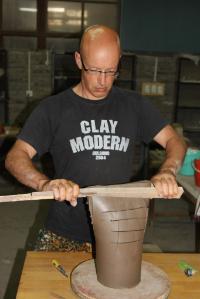Dr David Jones, Faculty of Arts
 David Jones holds a PhD from Manchester Metropolitan University; his BA subjects were Philosophy and Literature, graduating from Warwick University. He is an elected Member of the International Academy of Ceramics and will represent the UK, Ireland and Benelux on the IAC Council from 2016-2022. He is a fellow of the Crafts Potter Association of England. Since 1987 he has been a senior lecturer at the University of Wolverhampton, UK, teaching on the BA and post-graduate programmes.
David Jones holds a PhD from Manchester Metropolitan University; his BA subjects were Philosophy and Literature, graduating from Warwick University. He is an elected Member of the International Academy of Ceramics and will represent the UK, Ireland and Benelux on the IAC Council from 2016-2022. He is a fellow of the Crafts Potter Association of England. Since 1987 he has been a senior lecturer at the University of Wolverhampton, UK, teaching on the BA and post-graduate programmes.
The clay work has been predominantly in the field of raku-fired ceramics, resulting in deep-black, smoked surfaces with lustres; these have been exhibited as unique objects as well as installations using firing as a metaphor. This work has been underpinned by the authoring of two books: Firing – Philosophies within contemporary ceramic practice (2007) and Raku, Investigations into Fire, (1999).
This theoretical work has been extended through the presentation of papers to many international symposia. The recently completed PhD at Manchester Metropolitan University has led to work in new directions in installation practice, utilising the blackening and burning of ceramic surfaces to allude metaphorically to the elision between clay bodies, vessels and human bodies, bringing a recognition of my identity as a 2nd. Generation Holocaust-survivor.
His ceramic work is held in many international collections including Boymans Van Beunigen, Rotterdam; FuLe International Museum of Ceramics , Fuping, Xian, China; Inax Gallery, Tokyo, Japan; Yingge Ceramics Museum, Taipei, Taiwan; Staatliches Museum für angwandte Kunst, Munchen, Germany.
Clay Bodies: An Exploration of the Possibilities that a Language of Ceramics Offers to Explore Meaning in Conflicted Histories
David Jones’ clay work has been predominantly in the field of raku-fired ceramics, resulting in deep-black, smoked surfaces with lustres; these have been exhibited as unique objects as well as installations using firing as a metaphor.
The recently completed PhD at Manchester Metropolitan University has led to work in new directions in installation practice, utilising the blackening and burning of ceramic surfaces to allude metaphorically to the elision between clay bodies, vessels and human bodies, bringing a new recognition of my identity as a 2nd. Generation Holocaust-survivor.
The interruption of the State bureaucracy in Leipzig will constitute a shelving system that echoes the stacked bunks of humans in the concentration camps. It will emphasise the role that advanced bureaucracy and division of labour played in the murder of 11 million people including 6 million Jews in the Holocaust. Items to be placed on the shelves will be communally made in collaboration: with the public also including faith groups, refugees.
Introduction:
The ERAS award was used to buy myself out of teaching two modules. This was incredibly valuable, as it provided time to devote to my practice as an artist and writer. I initiated a collaborative project titled “Clay Odyssey”, in Leipzig at the internationally renowned Grassi Museum of Applied Arts. It also allowed time to critically contextualise the practice through a book chapter and journal article.
Outcomes:
- Collaborative work with asylum seekers, Installation at the Grassi Museum, Leipzig.
- book chapter : The creative potential of the Post Industrial Landscape, in peer-reviewed book of conference essays: Material Memory: The Post Industrial Landscape as Site for Creative Practice (ed. Heeney, G.) ISBN(13): 978-1-4438-9937-6.
The writing that I commenced on the ERAS writing retreat has been published in the journal: Craft Research, titled: Leaving Traces.
Future Plans:
As a result of the work made possible by the ERAS award, I have been offered a major installation space at Der Spinnerei, one of the leading fine-art venues in Europe for June 2019.


/prod01/wlvacuk/media/departments/digital-content-and-communications/images-2024/240328-Varsity-Line-Up-Resized.jpg)
/prod01/wlvacuk/media/departments/digital-content-and-communications/images-18-19/220325-Engineers_teach_thumbail.jpg)
/prod01/wlvacuk/media/departments/digital-content-and-communications/images-2024/240423-Additive-Research-Centre-Launched.jpg)
/prod01/wlvacuk/media/departments/digital-content-and-communications/images-2024/240320-Uzbekistan-Resized.jpg)
/prod01/wlvacuk/media/departments/digital-content-and-communications/images-2024/240229-The-Link-Resized.jpg)
/prod01/wlvacuk/media/departments/digital-content-and-communications/images-2024/240416-Abi-Dare-Resized.jpg)